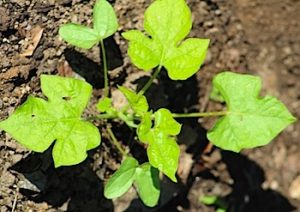The Vine That Binds Us
By Carmine Carosella, Fairfax Master Gardener
Ah, the beautiful morning glory! They provide flowers in many colors for pollinators and instant summer shade as they weave up structures, even a favorite of hummingbirds. I remember the sky-blue flowers growing up telephone wires in Boston, easily twenty feet long. But wait, do you want them wrapping themselves around your garden fences, hiding in your tomato plants, climbing your bean poles? Morning glories become a nasty weed in the vegetable garden and can rapidly take over your plants. What’s a gardener to do? Well here are some thoughts.

Convolvulus arvensis

Ipomoea hedercea
Pre-emergent chemicals are completely ineffective in stopping the morning glory seeds from germinating as they keep sprouting throughout the season. Vigilance with hand-pulling or hoeing is a must. And the plants camouflage themselves so well with pole beans. Usually the first sign of attack is a blooming flower instead of a bean. Pick off the flowers and cut the vine near the ground. Removing the vine itself is usually impossible.
You’re faced with a multi-year task once the morning glory seeds are in the ground. Thick mulches along fence lines will prevent seedlings from sprouting in the spring. But constant vigilance is the only true solution. Good luck!
References
Ivyleaf and Entireleaf Morning Glories, Michael Flesser, Virginia Tech Weed Identification Guide
Morning Glory Control, Bonnie L. Grant, Gardening Know How
Ivy-Leaved Morning Glory, Illinois Wildflowers